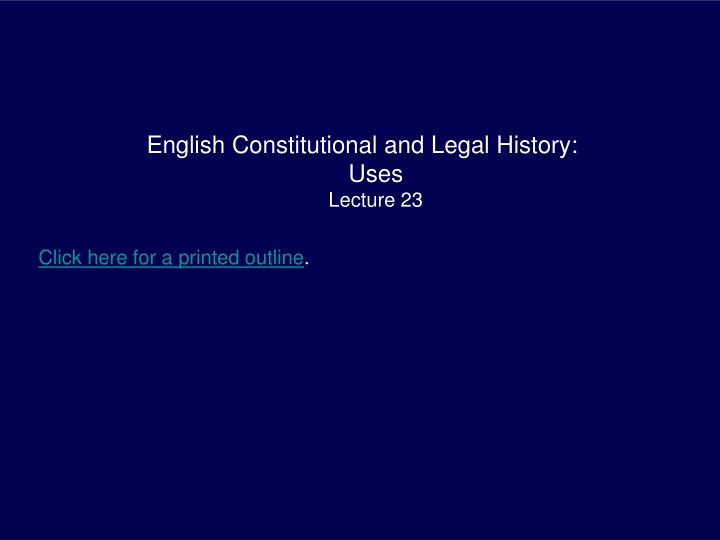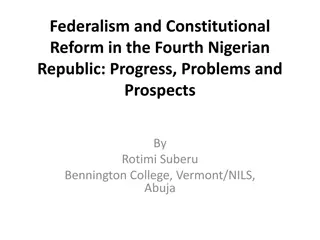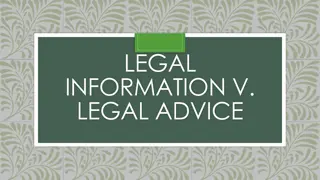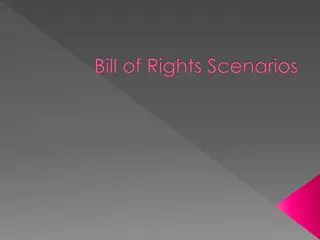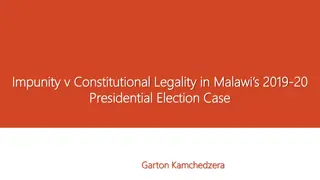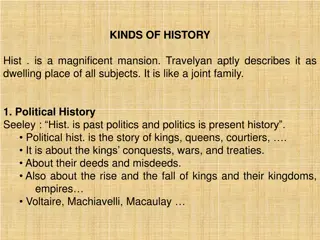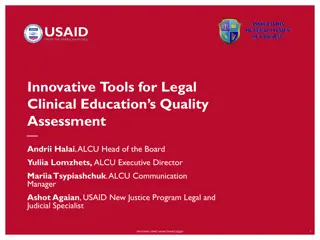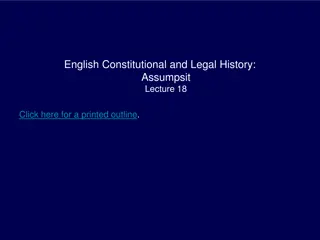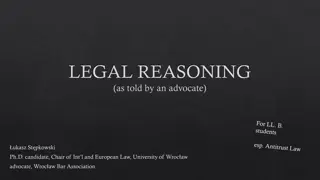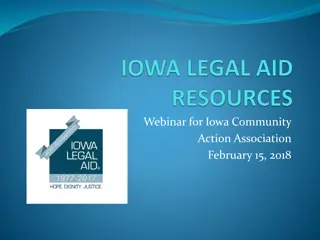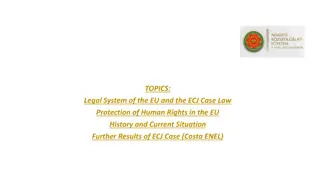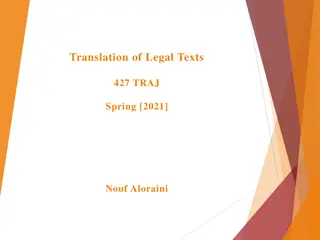English Constitutional and Legal History: Uses
Medieval uses in property law were rooted in the need to circumvent legal restrictions and achieve specific purposes such as avoiding statutes and ensuring continuity of ownership. Lords utilized ad opus arrangements, conditional grants, and testamentary dispositions to control property through trusted intermediaries. The evolution of uses shaped early property transactions and established precedents that influenced modern trust concepts.
Uploaded on Feb 21, 2025 | 1 Views
Download Presentation

Please find below an Image/Link to download the presentation.
The content on the website is provided AS IS for your information and personal use only. It may not be sold, licensed, or shared on other websites without obtaining consent from the author.If you encounter any issues during the download, it is possible that the publisher has removed the file from their server.
You are allowed to download the files provided on this website for personal or commercial use, subject to the condition that they are used lawfully. All files are the property of their respective owners.
The content on the website is provided AS IS for your information and personal use only. It may not be sold, licensed, or shared on other websites without obtaining consent from the author.
E N D
Presentation Transcript
English Constitutional and Legal History: Uses Lecture 23 Click here for a printed outline.
What is a use? Pur avoider le stuffing del rolls ove multip Title to the property is held by someone other than the person who gets the benefits from the property. The modern trust (or the Roman fideicommissum or the Islamic waqf) are examples. The medieval feoffment to uses: feoffor, feoffees, cestui que use. O >A, B, and C and to the survivor of them, to the use of O. This is a feoffment to uses. The conveyance would be made by the ancient form of conveyance of a freehold, by feoffment with livery of seisin. A, B, and C, are the feoffees. They hold by joint tenancy with right of survivorship, which means that when one of them dies the others inherit and the heirs of the first to die do not inherit. The person who has the use (O in this case) is called the cestui que use.
What is a use? (contd) Who are the feoffees? People whom O trusts. Most medieval uses were passive: the feoffees didn t manage the property.
The orgins of the medieval use. Lords holding ad opus their tenants, surrender and regrant, remained common with copyhold which was not subject to Quia emptores. Use of a straw where one wanted to make a conveyance to one s self. One can t make a livery of seisin to one s self if one already has the seisin. I might want to convey my land to hold by myself and my wife, or I might want to convey my land to hold in fee tail rather than fee simple. The Franciscans. Avoidance of statute of Mortmain (1279), statute of 1391.
The orgins of the medieval use. Conditional grants, e.g., a grant to feoffees to hold until the religious house got a mortmain license. Rule that the conditions had to be fulfilled within the lifetime of the feoffor, perhaps the beginnings of a Rule Against Perpetuities. Guardians in socage. Staute of Westminster I (1275). Here the guardians are more like modern trustees. Testamentary dispositions. A grant to feoffees to hold to the use of the feoffor s will. The arrangement becomes permanent.
Uses and the law Common law, after some hesitancy, does not recognize interest of the cestui. In 1464 the feoffees were allowed to sue the cestui in waste for cutting trees on the land. Chancery does recognize it. By 1425 2/3 of the work of the Chancellor s court involved uses. Complicated cases: Between 1450 and 1483 it was established in Chancery that the heir of the feoffee was bound by the use. Sometime before 1463 it was established that conveyees of the feoffees were bound by the use unless they had paid value for the land and had no notice of the use (the concept of the bona fide purchaser without notice of the equity [our b.f.p.]).
Uses and the law (contd) The notion of the resulting use: By the late 15th century (possibly as early as 1465) uses had become so common that it came to be held that if a conveyance was made and no consideration passed for the conveyance, chancery would assume that the purpose of the conveyance was for the feoffees to hold to use of the feoffor. Perhaps even more remarkably it came to held that if consideration was paid for land and the conveyance was not made, the person who received the consideration would be deemed to hold the land to the use of the person who paid the consideration. Statute of 1 Richard 3, c.1 (1484) allows the cestui que use to make a feoffment of the land even without the concurrence of the feoffees.
Uses, c. 1500 In 1500 Serjeant Frowyk estimated that half the land in England was held to uses, and a generation later St. German confirms that the practice was widespread (Mats. p. IX 35): And sometimes such uses be made that he to whose use, etc., may declare his will thereon: and sometime for surity of divers covenants in indentures of marriage and other bargains. And these two last articles be the chief and principal cause why so much land is put in use. The rigidities of the common-law of inheritance. The principal rigidity the people wanted to avoid seems to have been the failure of the common law to make provision for younger sons and daughters. The principal devices for avoiding these rigidities were the common recovery (which we ll talk about in a later lecture) and the use. By last quarter of the 15th century, if not before, no entail could be maintained if the present holder didn t want it to be maintained. That s the common recovery. The use proved to be the method whereby new settlements could be made without at the same time depriving the landowner of the benefits of the land during his lifetime.
The will of Lord Dacre of the Sourth, 1533 (Mats. p. IX91) Almost all of the lord s land was held by feoffees to uses. They were to hold the chief manor, Herstmonceaux in Sussex, for a year to raise money for the staff, and then hold it for Thomas, the lord s heir, his grandson, his eldest son, William, having predeceased him, until Thomas was 24 and convey it to him in fee tail male, with remainder in fee tail male to his second son, with remainders over. They were to convey other manors and lands to his younger sons directly in fee tail male, with remainders over. The lord s wife was to get a substantial amount (over 100), apparently annually from the income of all his lands, as part of his marriage settlement with her, and also a manor, the value of which is not given.
The will of Lord Dacre of the Sourth, 1533 (contd) The feoffees were to use the income from about a third of the lord s remaining lands for the performance of my will. This was almost certainly to pay his debts and funeral expenses, and probably to pay various legacies to people or institutions. The income from the rest of his lands was to be used to raise a marriage portion of 500 marks ( 333) for the lord s niece. After this was done, they were to make all these lands over to his heir in tail male after he had reached the age of 24. The annual value of all of the lord s holdings was estimated at over 1000. Taking out the lands that were eventually to end up in the hands other people, the annual value of the land that his heir would receive was slightly over 700. Thomas, the heir, was 18 at the time; had the lord s will been executed, he would not have gotten access to this money until he was 24.
Disadvantages of the use from the point of view of public policy. Secret conveyance. No one knew who really owned what.. Evasion of feudal incidents. There are references to evasion of feudal incidents in the Statute of Marlborough at the end of Henry III s reign and a number of Inquisitions Post Mortem of the 14th century apply the notion of fraud on the king s rights. This would not normally be held in a case like Lord Dacre s.
Fiscal feudalism. Statutes in the reign of Henry VII (1489, 1504) the heir of the intestate cestui (but not the devisee) subject to the incidents. Proposed statute of 1529. Henry VIII, desperately in need of cash to finance his French wars, cut a deal with the peers. One-third of the land held to use would be subject to the feudal incidents. The Commons rejected the deal in 1532. Arguments against the use and Lord Dacre s Case (1535). The CP, relying on the 1484 statute, was suggesting that uses were subject to the common law. Some argued that uses are dishonest. This argument is found in Doctor and Student, with the obvious corollary that they are not to be enforced in equity. All of these arguments and more were well summarized by Thomas Audley in a reading that he gave (on a stat. of 1489) at the Inner Temple in 1526.
Fiscal feudalism. (contd) Audley became Chancellor on the resignation of Thomas More in 1533. In 1534 he appointed Thomas Cromwell as master of the rolls. In 1535 Audley heard Lord Dacre s Case in Chancery in the presence of all the judges of England and Cromwell. The vote was originally 5 to 5, but Port J. mumbled and was counted on the wrong side. The resulting minority were later persuaded to give way to the majority by promise of the king s good thanks. The case held that it was against the nature of land to be devisable by will, and that a will of the use of land was just as invalid as the will of the land itself. Statute of Uses (1536): Under it, legal title in a feoffment to uses passed automatically to the cestui que use. Much more important for parliament at the time, all previous feoffments to uses and the conveyances made pursuant to them were validated. Statute of Enrollments (1536): Designed to eliminate the problem of secret conveyances by requiring that the bargain and sale of freeholds be recorded.
Fiscal feudalism. (contd) Statute of Wills (1540): Authorized, for the first time, the devise of much of English land, a devise that would be valid in law. One-third of the land devised by a tenant in chief would be subject to the feudal incidents. The same parliament also established a separate court of wards, so great was the anticipated wardships from the new statute. The king s success was short-lived. By the end of the 16th century ways had been found once more to avoid the feudal incidents. The abolition of military tenures in 1660 marks the formal end of the feudal incidents, but they had long since ceased to be of real practical consequence. The Statute of Enrollments was even shorter lived, as methods were found to avoid its reach by using a form of conveyance different from bargains and sales of freeholds. Except for copyhold, public records of land-titles are the product of the 20th century in England
What happened next? The Statute of Uses put an end to estate-planning flexibility like that employed by lord Dacre. The statute of wills in 1540 restored the power to devise but it was still not clear just how much could be accomplished under the statutes. The story is very complicated. I can only mention a few of the developments here. The first step logically, if not chronologically, was with regard to the active use. A simple example is the trustees to raise portions in Lord Dacre s will. If I enfeoff someone to raise portions or instruct the executors in my will to hold land to raise portions, the use will not be executed under the statute until the portions have raised, and in the meantime Chancery will supervise the feoffees, now called trustees, or the executors.
What happened next? (contd) Not only can this be used to raise portions, but it can also be used for marriage settlements. If I want my daughter to have an independent income of her not subject to her husband, I can give property to trustees and tell them to manage it and pay the income to my married daughter. This is woman s separate equitable estate, and it was quite common in the early modern period.. The rise of the charitable use. Remember the Franciscans and the Statute of Mortmain. Note the Elizabethan Statute of Charitable Uses (1602) confirming practices that had developed over the past 67 years.
Future interests after the Statute of Uses After the passage of the Statute of Uses the courts began to ask what kinds of future interests could have been created in equity prior to the statute. The discussion was quite academic, because entailed uses are the only types of future interests in uses that are discussed prior to the S/Uses, and this so far as we can tell was itself only academic. All the real cestuis prior to the statute, again, so far as we can tell, had what at law would have been regarded as a full fee simple absolute. The first and most obvious problem was what to do with the simple creation of a life estate and a remainder by way of a use: O >to A to use of B for life remainder to C. The problem was that the seisin was in B by the statute; nothing in the statute spoke of B s seisin supporting a remainder. James Dyer, CJCP, who died in 1582, said that the remainder was supported by the spark of right, scintilla iuris, that remained in the feoffee after the statute executed the use. The same idea was applied to executory devises created by wills by brute force, because nothing in the statute of wills speaks of execution of uses.
Future interests after the Statute of Uses (contd) In 1595, the old Exchequer Chamber decided Chudleigh s Case, a case that says that contingent future interests can be destroyed by the present holder of the life estate conveying to the holder of a vested interest that followed the contingent interest.The rule applied both to contingent remainders and to executory interests, a new form of future interest that had been concocted on the basis of the Statute of Uses. But the King s Bench reversed course in Pells v. Brown in 1620. That case holds a contingent executory interest was not destroyed when the present holder of the fee subject to a contingent executory interest suffered a common recovery. The fact that executory interests were indestructible ultimately led to the modern rule against perpetuitities, in the second half of the 17th century. We ll talk about that in a future lecture. The fact that contingent remainders were destructible lead to the creation of the strict settlement. We ll also talk about strict settlement in a future lecture. From the point of view of history, the strict settlement is more important than the modern rule against perpetuities.
